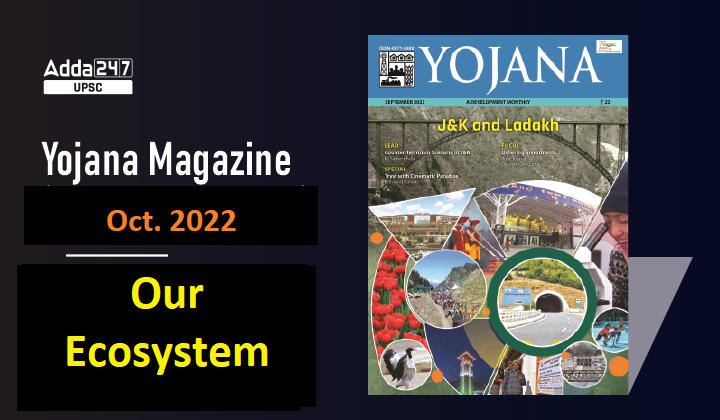Table of Contents
Our Ecosystem: Introduction
- The life, as we see around us, is said to be a phenomena of around 3.8 billion years with signs of biological activity even before that.
- Where we live today took shape when the Indian subcontinent drifted apart from the bigger landmass of Gondwana and almost settled itself to the lower part of the existing landmass.
- It also brought along with it the species from its parent land and waters that adapted and evolved according to the newer environment. Humans emerged much later when all these changes had mostly settled down.
Our Ecosystem: What is an ecosystem?
- An ecosystem is a natural environment and includes the flora (plants) and fauna (animals) that live and interact within that environment.
- The delicate balance between these lives and us is what forms the ecosystem. It is our basic life support system – abiotic system that includes the air we breathe, the land we live on, the water we drink as well as the biotic system, i.e., the vegetation that provides us the food, and the living beings that surround us.
- Flora, fauna and bacteria are the biotic or living components of the ecosystem.
- Ecosystems are dependent on the following abiotic or non-living components:
- climate – the temperature and amount of rainfall are very important in determining which species can survive in the ecosystem
- soil – the soil type is important as this provides nutrients that will support different plants
- water – the amount of water available in an ecosystem will determine what plants and animals can be supported
- The biotic parts of the ecosystem have a complex relationship with the abiotic components – changing one will lead to a change in the other.
- The unique topography of Indian subcontinent
- The unique topography of Indian subcontinent has blessed the land with various landforms, forests, water bodies, wetlands, and climate that let varied forms of lives flourish around us.
- Different organisms are found in different ocean depths, providing a colourful spectrum to marine life and its ecosystem.
Our Ecosystem: What is Marine Ecosystem?
- Marine ecosystems contain a diverse array of living organisms and abiotic processes. From massive marine mammals like whales to the tiny krill that form the bottom of the food chain, all life in the ocean is interconnected.
- While the ocean seems vast and unending, it is, in fact, finite; as the climate continues to change, we are learning more about those limits.
- According to scientific studies, so far, about 2.5 lakh marine life species have been identified all over the world.
- Scientists estimate that two million more species existing in the ocean are yet to be discovered.
- India’s Marine Ecosystem
- The Andaman and Nicobar Islands, for example, support a luxuriant and rich vegetation due to tropical hot and humid climate with abundant rains.
- The coral reefs of these islands is the second richest found in the world.
- They provide different varieties of animal life of which, the coral reefs ecosystem constitute the most fragile and interesting faunal element as elsewhere in the Indo-Pacific Reefs.
- Gujarat is one of the rich biodiversity States, which is indicated by the presence of 7,500 species of flora and fauna, of which 2,550 are angiosperms, 1,366 are vertebrate species, 574 are bird species and rest are mammals, reptiles, amphibians, fish, etc.
Our Ecosystem: What is Biodiversity?
- Biodiversity is the variety of all life on Earth – animals, plants, fungi and micro-organisms like bacteria.
- Animals and plants provide humans with everything needed to survive – including fresh water, food, and medicines.
- However, we cannot get these benefits from individual species – we need a variety of animals and plants to be able to work together and thrive. In other words, we need biodiversity.
- Biodiversity in NER of India
- Biodiversity plays a pivotal role in maintaining the ecological balance in nature and is found in abundance in Northeastern region (NER).
- The region sharing Himalayas and Indo-Burma biodiversity hotspots, serves as the native habitat for valuable natural flora and fauna.
- Challenges:
- Nowadays, indigenous bioresources of NER have experienced a number of challenges, such as habitat destruction due to rise in human population, illegal mining, landslide, and overutilisation and illegal trading of medicinal plants.
- The government is undertaking several initiatives to overcome these as well.
Our Ecosystem: What GOI is doing for maintaining and conserving ecological balance?
- With the intent to have a holistic view for maintaining and conserving ecological balance, India is taking several measures.
- It has banned the manufacture, import, stocking, distribution, sale and use of identified single use plastic items, which have low utility and high littering potential, all across the country from 1 July 2022.
- Another initiative taken by the Government is National Mission for a Green India. It is one of the eight Missions under the National Action Plan on Climate Change and was launched in order to safeguard the country’s biological resources and associated livelihoods against the perils of Climate Change.
- It aims at protecting, restoring, and enhancing India’s forest cover and responding to Climate Change.
- It also aims at recognising the vital impacts of forestry on ecological sustainability, biodiversity conservation, and food, water, and livelihood security for the nation.
Conclusion
Humankind represents a very small fraction of the universe, which encompasses innumerable species of plants and animals around us. So, to fight with rising climate change problem, we need to live consciously with our fellow earthlings.



 TSPSC Group 1 Question Paper 2024, Downl...
TSPSC Group 1 Question Paper 2024, Downl...
 TSPSC Group 1 Answer key 2024 Out, Downl...
TSPSC Group 1 Answer key 2024 Out, Downl...
 UPSC Prelims 2024 Question Paper, Downlo...
UPSC Prelims 2024 Question Paper, Downlo...
